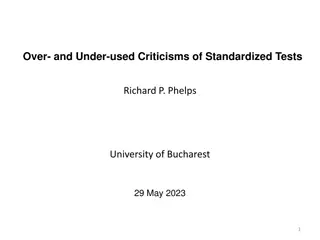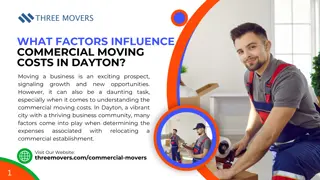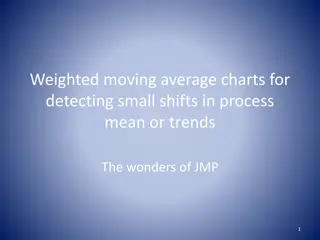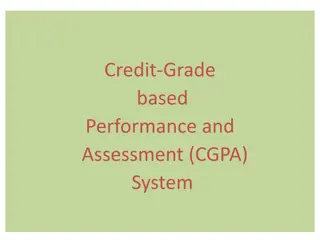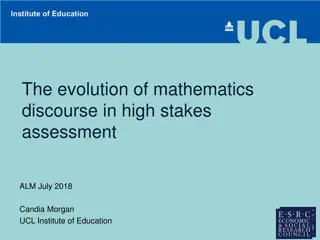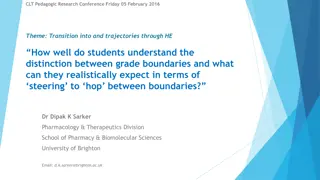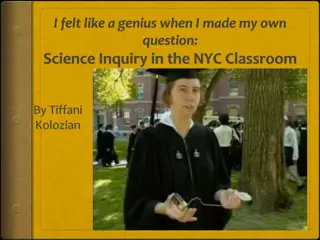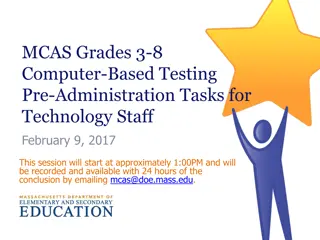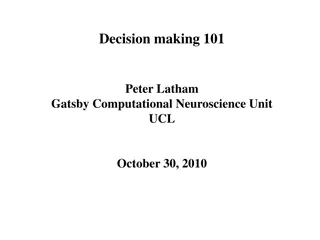Rethinking Assessment in Education: Moving Beyond Grades and High-Stakes Testing
Embracing a gradeless approach and critiquing high-stakes testing, the education system shifts focus to learning and growth, promoting detailed feedback, open revisions, and prioritizing student well-being over constant assessment pressure and anxiety-inducing traditional tests. Potential issues with traditional tests and grades are highlighted, advocating for a more holistic and student-centered evaluation system.
Download Presentation

Please find below an Image/Link to download the presentation.
The content on the website is provided AS IS for your information and personal use only. It may not be sold, licensed, or shared on other websites without obtaining consent from the author.If you encounter any issues during the download, it is possible that the publisher has removed the file from their server.
You are allowed to download the files provided on this website for personal or commercial use, subject to the condition that they are used lawfully. All files are the property of their respective owners.
The content on the website is provided AS IS for your information and personal use only. It may not be sold, licensed, or shared on other websites without obtaining consent from the author.
E N D
Presentation Transcript
TEACHERS GOING GRADELESS DR. AUDREY BULLOCK DR. MARYLU DALTON AUSTIN PEAY STATE UNIVERSITY
WHAT DOES GOING GRADELESS MEAN? A focus on learning and growth rather than averaging or accumulating points Grades may or may not be given at the conclusion of a course Feedback is detailed and specific, including written and oral comments Revisions are allowed and expected
THE VICIOUS CYCLE OF HIGH STAKES TESTING State says- We re going to test once or twice a year District says- Let s do benchmark tests 4-5 times a year to make sure students are ready for those state tests Some districts say- Let s do common tests at the end of each unit or weekly to make sure students are ready for the benchmark tests Teachers feel pressure that they might be judged if students perform poorly on any of these, so they might do even more testing/prep In an effort to make data-driven decisions, we are over-testing our students and reducing them to nothing more than a score or color, when we know they (and their needs and strengths) are much more complex Students and teachers feel stressed and overwhelmed by the constant formal assessment- contributing to an all time high suicide rate for teens and adolescents
THE VICIOUS CYCLE OF HIGH-STAKES TESTING Teacher testing to prep students State Testing Schools Common Unit Tests District Benchmark Testing
POTENTIAL ISSUES WITH TRADITIONAL TESTS Communicate a fixed mindset Do not test real mathematics Number sense and Application Emphasize speed over deep thinking- Lowest performing students relied on memorization rather than sense-making (OECD, 2013) When timed, cause anxiety that masks what students actually know (Beilock, 2011) Timed tests in third grade (Boaler, 2014) 69% of students report anxiety during testing and 37% also experience it during test prep (PISA, 2015)
POTENTIAL ISSUES WITH GRADES Grades are an example of ego feedback As students progress from 5thto 12thgrade, grades become more and more fixed and are negatively correlated with what students believed they were capable of achieving after high school (Deevers, 2006) If any score on an assignment were equally likely, what letter grade would most students have? Unbalanced grading scales (Boaler, 2016) Inflation
GRADE SCALE: A = 90 - 100 A 90 - 100 B 80-89 GRADE SCALE: A = 93 - 100 C 70-79 A 93 - 100 D 60-69 B 85 - 92 F 0 -59 C 77 - 84 D 70 - 76 F 0 - 69
LESSONS WE MIGHT LEARN FROM OTHER COUNTRIES Most countries that lead the world in mathematics achievement do the following in comparison to the U.S. (Finland, Japan, China) Test way less- maximum of one time per year, which is not used as a threat against teachers or students Hardly ever give standardized tests to students before 10thgrade Typically don t grade students at all with letters or numbers until high school Spend much less time on homework Attend school for fewer days per year and hours per day Start attending school at an older age
IS THERE RESEARCH SUPPORT FOR THIS? San Diego- Teachers stopped giving chapter tests and preparing students specifically for district/state tests. They taught rich, connected mathematics and gave students mini- assessments, called show what you know. Within the first year, standardized test scores caught up to neighboring districts, and anxiety and negative dispositions significantly declined, for students and teachers (Boaler, 2016). The following year- teachers stopped grading completely and gave feedback instead. Failure rates halved, and algebra and geometry scores surpassed neighboring districts with less diversity and higher average income
IS THERE RESEARCH SUPPORT FOR THIS? If formative (ungraded) assessments were used throughout the year instead of summative tests, it would result in enough growth to move the entire country from middle of the pack to top five in mathematics achievement (Black, Harrison, Lee, Marshall, & Wiliam, 2002). Students are accurate when self-assessing their understanding (Black et al., 2002). Students receiving comments only consistently outperform students receiving grades only as well as grades and comments. (Elawar & Corno, 1985; Butler, 1987; Deevers, 2006) Comments don t need to be given that often to have this effect (Boaler, 2016, pg. 167)
BUT HOW DO I MAKE SURE THEY DO THEIR HOMEWORK? Students report homework as the major source of stress in their lives Schools that did away with homework saw no decline in achievement and significant improvement in the home lives of teachers and students (Kohn, 2008; Challenge Success, 2012; PISA, 2015) Homework widens the achievement gap- those that do it and have help at home are those that need extra practice the least
NATURE OF HOMEWORK One or two Reflection questions on class content and work focusing on deeper understanding Perhaps a few problems - Not 30 problems of drill and practice
IS THAT EVEN ALLOWED? DOES ANYONE ELSE DO IT? Many states have implemented or are piloting alternatives to a single high stakes assessment Brown University- students can choose to be graded on A-C scale (no Ds or Fs), or Satisfactory/Unsatisfactory scale MIT- Grades first semester don t count towards GPA and can only be seen by a student and his/her advisor, and only A-Ds count ever. Many other private or smaller universities operate on pass-fail systems Several mega-districts in New York, Chicago, and San Diego have gone completely gradeless and have seen all positive results (Boaler, 2016)
BUT, IN THE REAL WORLD They won t get several chances Most college courses now offer some revisions or alternative assessment methods ACT, SAT, licensing exams for nurses, doctors, pilots, teachers, actuaries . Very few careers are you expected to be an expert within weeks/months They will be graded/scored/evaluated Probably not, especially not with questions/criteria unknown to them Typically reviews are in the form of comments, diagnostic feedback, and time for improvement It takes about 10,000 hours of practice to become fluent and master a field of study (Gladwell, 2011) 13 years of school, 200 days/year, 2 hours per day- We re barely half way there (5,200 hours)
WHAT ALTERNATIVES ARE THERE TO TRADITIONAL GRADING? If you must use numbers and letters, use a scale that doesn t make F an overwhelming proportion of the scale. Standards mastery Portfolios Grade contracts Conferences/ Interviews No grades- just learn, deal with behavior issues as they arise A More Equitable Distribution of Grades A B C D F
MATH 1420 STRUCTURE Math content course for teachers Final letter grades are required 20% - Being a productive mathematician 80%- Portfolios that have rubrics for each standards Students choose problems Peer feedback, self-assess, instructor feedback Limited number of revisions allowed Points that make up 80% come from student self-assessment (with instructor approval)
MATH 4100 STRUCTURE Math methods course for teachers Final letter grades required Grade contracts created first day of class An A looks like . A B looks like . No points, percents, or letter grades on anything submitted, just diagnostic comments to further student learning Students self-assess their level of work often and compare to instructor expectations Instructor tracks student progress as proficient, approaching proficiency, or needs revisiting Conference with students as needed about progress
PLACES TO LEARN ABOUT OR GET INVOLVED IN TEACHERS GOING GRADELESS Mathematical Mindsets- Jo Boaler (2016) What s Math Got To Do With It?- Jo Boaler (2015) Race to Nowhere film (free on youtube.com) Twitter- Teachers Going Gradeless, follow Dan Meyer Facebook groups (AMTE s Rethinking Grades, Teachers Going Gradeless, Teachers Throwing Out Grades)
REFERENCES Beilock, S. (2011). Choke: What the secrets of the brain reveal about getting it right when you have to. New York: Free Press. Black, P., Harrison, C., Lee, C., Marshall, B., & Wiliam, D. (2002). Working inside the black box: Assessment for learning in the classroom. London: Department of Education & Professional Studies, King s College. Boaler, J. (2014). Fluency without fear: Research evidence on the best ways to learn math facts. Youcubed at Standford University. Retrieved from https://www.youcubed.org/evidence/fluency-without-fear/ Boaler, J. (2015). What s math got to do with it: How teachers and parents can transform mathematics learning and inspire success. New York: Penguin. Boaler, J. (2016). Mathematical Mindsets. John Wiley & Sons. Butler, R. (1987). Task-involving and ego-involving properties of evaluation: Effects of different feedback conditions on motivational perceptions interest and performance. Journal of Educational Psychology, 79, 474-482. Challenge Success. (2012). Changing the conversation about homework from quantity and achievement to quality and engagement. Stanford, CA: Challenge Success. Retrieved from https://www.challengesuccess.org/wp-content/uploads/2015/07/ChallengeSuccess-Homework-WhitePaper.pdf Deevers, M. (2006). Linking classroom assessment practices with student motivation in mathematics. Paper presented at the American Educational Research Association, San Francisco. Elawar, M.C., & Corno, L. (1985). Opportunity-to-learn standards and the state role in education. Teachers College Record, 96(3), 432-457. Gladwell, M. (2011). Outliers: The story of success. Back Bay Books. Kohn, A. (2008). Teachers who have stopped assigning homework (blog). Retrieved from https://www.alfiekohn.org/blogs/teachers-stopped-assigning- homework/ Organization for the Economic Cooperation and Development (OECD). (2013). Lessons from PISA 2012 for the United States, strong performers and successful reformers in education. Paris: OECD. Program for International Student Success (PISA). (2015). Does homework perpetuate inequities in education? PISA in Focus 46. Retrieved from https://www.oecd.org/pisa/pisaproducts/pisa-in-focus-all-editions.htm Program for International Student Success (PISA). (2015). Is too much testing bad for student performance and well-being? PISA in Focus 79. Retrieved from https://www.oecd.org/pisa/pisaproducts/pisa-in-focus-all-editions.htm
DISCUSSION AND SHARING What ideas do you have? Would you like to try something like this? Have you tried something like this? How did it go? Pros and cons?


